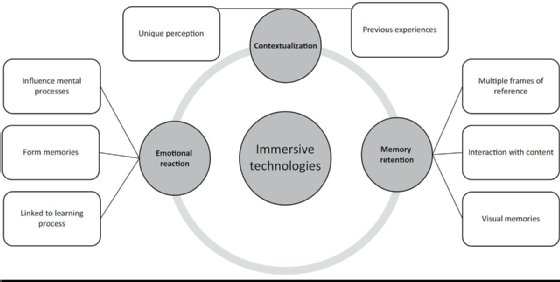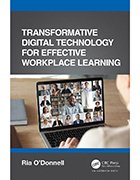6 workplace benefits of immersive learning with AR and VR
AR and VR have the potential to enhance workplace learning programs. Learn how both employees and organizations can benefit from immersive learning with AR and VR.
As digital transformation continues in the workplace, businesses and employees must make efforts to keep up with changes. Continuing professional development and education are key for organizations to support company culture, keep employees engaged and maintain a competitive edge in a new world of work.
Digital technologies will become an integral part of workplace learning programs as organizations evaluate advanced training tools, as well as new skills employees must learn. In the book Transformative Digital Technology for Effective Workplace Learning, published by Taylor & Francis, author Ria O'Donnell explores the future of the workplace, the need to update workplace learning and the role of digital technology.
In this excerpt from Chapter 7 of Transformative Digital Technology for Effective Workplace Learning, O'Donnell discusses how augmented reality and virtual reality can enhance workplace learning programs and explores six benefits of immersive learning with AR and VR.
The Benefits of Using Immersive Technologies for Workplace Training
Many studies have examined the use of immersive technologies for learning and have revealed benefits in a variety of industries such as medicine, military, and higher education (Rogers et al., 2020; Ahir, Govani, Gajera & Shah, 2020; Awoke et al., 2021). These benefits include examples such as risk reduction, reduced time taken to train staff, increased contextualization, cost savings, emotional responses, and memory retention.
1. Risk Reduction
Learners can engage with different types of training experiences within VR and AR environments to make mistakes without real-world consequences. As risks are minimized or eliminated, they can practice their skills in the virtual environment and increase their confidence in carrying out the task, so it can then be performed in the real world. This can be particularly useful when solving problems or implementing new solutions, as workers can test possible processes without the risk of adverse consequences (Gabajova et al. 2019) should the experiment not achieve the desired results.
Workers can experience simulated situations, such as an operating theatre in which a training surgeon can perform simulated openheart surgery without risking a patient's life (Newman, 2016). Or they might experience the production of a machine that allows for trial and error without the risk of damaging equipment or losing parts (Gabajova et al., 2019). These types of no-risk hands-on experiences can significantly streamline the learning process.
2. Time to Train
It has long been known that 'learning by doing' increases knowledge retention (Aldrich, 2005), which is proven in studies such as the experiments performed by Ekstrand et al. (2018) on the use of VR in neuroanatomy training. This study revealed that the integration of interactive reality might have significantly helped improve knowledge attainment and retention and reduce time to mastery, while at the same time, increasing motivation.
Another example is the Walmart training module called 'The Pickup Tower,' in which over a million associates were trained using VR, which reduced the training time from 8 hours to 15 minutes (Bailenson, 2020). This demonstrates when these types of training plans are implemented effectively, they can result in enormous time savings, and in turn, cost reductions for the company.
3. Cost Savings
While there are, of course, costs involved in setting up and maintaining simulated training environments for the workplace, there are also significant cost cuts in terms of hiring instructors, facilities, and physical equipment for the hands-on training.
However, the most significant cost-saving comes from the reduction in employee time spent training, practicing, and making errors. There is also the cost of secondary workers involved in training, such as supervising peers. These employees would no longer need to be removed from their role to shadow the learner while they master a skill, and instead, they can continue work on their primary tasks and provide support should it be required (Gabajova, 2019).
However, at the same time, there can be a significant outlay for equipment and applications to get an immersive technology training program started (these expenses are discussed below) and further costs for ongoing maintenance, updates, and support (Figure 7.2).

4. Contextualization
According to Surya & Putri (2017), contextual learning emphasizes the entire process of an individual's involvement in what is being learned and how they relate that to real-life situations and apply it to their own lives. This type of learning requires an empowering approach, allowing workers to construct knowledge in their own minds rather than merely memorizing instructions or facts (Crawford, 2001). When learning occurs, the mind naturally seeks meaning in the context of the learner's world and their previous experiences. New information is absorbed in a way that makes sense to the individual and their unique perception at that point in time. With this in mind, it makes sense to utilize immersive technology for learning as the simulated experience aligns closely with the real-life context of how it should be applied. Scavarelli et al. (2020) explain that contextual learning allows new knowledge and skills to be transferred more easily when memory recall is closely associated with the environment. In VR/AR, the environment can feel realistic, thus creating real memories of completing activities rather than relying on theoretical or abstract ideas.
5. Emotional Reaction
At a fundamental level, cognitive activity is motivated by basic emotional needs that evaluate new information first of all, in terms of survival, and secondarily to serve the processes of memory and learning (Tyng, Amin, Saad, & Malik. 2017). Emotional responses are central to forming memories (McGaugh, 2003). They influence mental processes, including attention, perception, problem solving, memory, and reasoning, which are all linked to the learning process (Tyng et al., 2017).
While emotional theory and research are complex, and in many cases, raise more questions than answers, it is safe to say that we know there is evidence of emotional experiences driving attention, motivation, learning, and memory (McGaugh, 2003), and this is what drives memory storage. Therefore, by immersing in real-life training experiences, it is more likely to garner emotion than learning through non-immersive, passive styles of instruction.
6. Memory Retention
Naturally, most people won't make significant memory connections when they read or hear about something compared to experiencing it for themselves. It is the improved immersion in learning that is beneficial and the opportunity to view multiple frames of reference (Scavarelli et al. 2020), which gives the learner a deeper understanding of how things work. As the participant touches and moves objects, pulls things apart, and examines systems, they gain first-hand experience, allowing them to form meaningful memories that are second only to the real-life activity.
The vividness with which the interaction is communicated in a VR environment, including the visual representations, enhances the cognitive responses. Cho (2018) recommends to VR content creators that this can be further enhanced by increasing spatial presence and high resolution.








